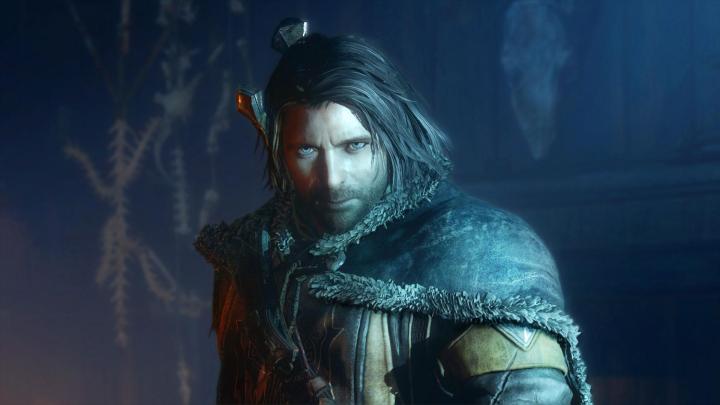
I’m going to step away from our usual preview format for this fresh look at Middle-earth: Shadow of Mordor. We’ve already taken a more structured look at various facets of Monolith Productions’ open-world action-adventure, but the so-called Nemesis System that was the focus of the new look exists to enable player-authored stories. The hour that I spent in an early section of the game differs dramatically from the hour that my colleagues spent playing it. I’m hoping that a more personal account conveys a sense of the depth and flexibility you can expect from the finished game when it launches on October 7.
Shadow of Mordor follows Talion, a human ranger from Gondor who is responsible for watching over the Black Gate leading to Sauron’s kingdom, is brought back after being killed by the dread lord’s army. He’s imbued with Wraith-like powers (a la the Nazgul) by his benefactor, who has a bone to pick with the mighty Sauron. Talion thus becomes a sword (and dagger and bow) of vengeance, traveling all throughout Mordor as he gains power and rallies previously unfriendly forces to aid him.
This latest look at the game takes Talion to the shores of the Sea of Núrnen, a surprisingly lush region of the dead lands. Rolling hills and craggy cliffs butt up alongside makeshift structures occupied by Sauron’s forces. Local wildlife, such as the lion-meets-lizard Caragor — that Talion can actually possess and use as a weaponized mount — roams freely, threatening to disrupt friendly and enemy actions alike. And Sauron’s forces are everywhere, from orc grunts and their human slaves to the mini-boss-like Captains and the Warchief bosses.

Captains and Warchiefs bring me to the final bit of background: the Nemesis System. The forces of Sauron in Middle-earth: Shadow of Mordor exist in their own sort of self-sustaining ecosystem. The hierarchy has five Warchiefs at the top of the ladder, each with up to three Captain bodyguards, from what I saw. If Talion does nothing at all, just sits around and stares at Caragors all day, the Warchiefs and their Captains — none of whom are necessarily friendly to one another (or even their commanders, in some cases) — will vie for power on their own, engaging in all manner of struggles.
Talion adds another variable to the mix, creating situations where individuals in Sauron’s army can potentially rise through the ranks. You might take on and successfully dispatch a Captain but end up being cut down by a lucky strike from one of the deceased Captain’s lackey grunts. That grunt would level up from taking down the powerful ranger, and likely assume the recently vacated Captain role. Or not. Similarly, Talion might brand a lackey — any enemy can be branded, effectively turning them over to Talion’s side — and, with the new ally’s help, take down a Captain. The newly allied lackey could then be installed as a Talion-supporting Captain and sent out on any number of missions, even one that involves assassinating and assuming the role of a Warchief.
The forces of Sauron in Middle-earth: Shadow of Mordor exist in their own sort of self-sustaining ecosystem.
Now that I’ve covered the basics, let’s look at how my demo played out. Monolith started Talion off in the Sea of Núrnen region with five Warchiefs to be unseated before the next section of the game could be played out. I settled on a particularly nasty fellow with two bodyguards; my plan was to snuff out the bodyguards separately — you can see where a Captain or Warchief is on the map when you highlight them on the Sauron’s Army menu — so I could take on a relatively defenseless Warchief. I knew I’d have to install a new, Talion-friendly Warchief at some point, but that was a worry for later.
Both of my Captain targets were hunkered down in a fort at the northern edge of the map, an elaborate wood-and-twine monstrosity built on a series of connected towering plateaus spiking up out of the sea. The first Captain, stationed near the entrance, had a fear of Caragors, but none of the beasts happened to be nearby when I came upon my target and his crew of lackeys. No big deal. The first Captain was actually just outside the gate to the fort, and his support was relatively light. A few minutes of Arkham-style counter-and-attack melee combat ended with the Captain dead and beheaded at Talion’s feet.

The second Captain proved much trickier. I liked seeing a susceptibility to stealth executions listed under his weaknesses, but he was tucked away at the northernmost end of the fort, deep in enemy territory. Fortunately, Talion, like all of Middle-earth’s rangers, is a nimble fellow, with climbing and parkour skills that wouldn’t be out of place in an Assassin’s Creed game. Shimmying my way along the fort’s outer walls, I managed to stay out of sight as I zeroed in on my target’s position. A large group of orcs threatened to blow my cover at one point, but a well-placed arrow released a caged Caragor in the camp, creating enough of a diversion for me to slip past.
I reached my target and found him all alone, guarded by nothing more than a lone archer in an adjacent tower. Perfect! After dispatching the archer, I ziplined my way across the nearby gap to my target’s location and crept along the top of the wall as I readied a stealth execution. Sadly, the flea-infested sack of jerk saw me and called for help. I managed to run him through, but was quickly overwhelmed by reinforcements before I could make my escape.
Any enemy can be branded, effectively turning them over to Talion’s side.
I made a beeline for the assuredly doomed Warchief as soon as Talion respawned and found him standing at the center of a stone bridge, directly between two groups of lackey orcs. Taking the sneaky approach, I was able to brand a handful of the unknowing lackeys to fight off the orc backup while I focused on the Warchief. Everything was going great… right up until Captain #2, miraculously restored to life(!), came running in to put a sword through Talion’s chest. It turns out that dead enemies can actually come back to life if you don’t take their heads off. My assault on the second Captain was quickly interrupted by reinforcements; I thought I had dispatched him, but I was wrong.
Truth be told, I admire that level of perseverance. This presumed dead Captain managed to cling to life after I left him badly maimed. Not only that, but he healed quickly enough to bounce back and defend his commander. Strong and loyal. Exactly the sort of ally I’d want to install as a friendly Warchief. So after respawning, I tracked the still-living Captain down and dueled him until he was at half-health, which allowed me to grab and brand him. Instead of simply converting him, I sent him off on a quest to assassinate his master.

It’s here that I learned another thing about Shadow of Mordor. If you brand a Captain and send him after his Warchief lord, the battle that ensues once you reach the mission marker on the map is a one-on-one duel, no reinforcements. I could have simply watched while the two duked it out, then branded the weakened winner, but I showed compassion. This Captain who had stared down death and come back from it, then planted a blade in Talion’s back… he deserved a shot at leading. So I hopped in to lend him a hand, only stepping back to let my new ally finish the job when the Warchief was down and clearly finished.
The entire plot that played out during this hour-long session was mine and mine alone. A person could try to replicate a similar set of circumstances, but the enemies arrayed against Talion were uniquely mine; their names, locations, weaknesses, and plot twists, all a product of my actions coupled with the game’s procedurally generated storytelling. Middle-earth: Shadow of Mordor is a legitimately exciting game to play based on the brief time we spent with it. There’s more to come at E3, so stay tuned.


